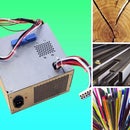Introduction: Choosing Greener Power Supplies
Saving energy is awesome! Choosing greener power supplies can make your geekadelic project more sustainable in one fell swoop.
If you want to save energy when building your new computer, robot, or other gizmo, there's one really easy way to make all of your electronics better: Buy an "80 Plus" certified power supply. And if your device will spend a lot of time idle, wire it up so that its idle state uses as little power as possible, too.

(Above) Image used by permission from plugloadsolutions.com
Efficient power supplies aren't just greener, they're better: they don't get as hot, so your system is easier to handle and can be kept in tighter places. It also means smaller fans (or no fan!), for quieter operation.
Step 1: Use an 80 Plus Power Supply.
Any electronics that're plugged into the wall have to convert AC to DC, and a lot of power supplies do that terribly inefficiently. Many units run at around 70%, but cheap ones can be 50%--that means that if your electronics need 100 watts, you're actually drawing 200 watts from the wall and half of it is getting dumped as heat before it even gets to your circuits!
So how efficient can your power supply get? You might guess the name "80 Plus" means 80% efficient or more, and you're right. They have six levels of certification, though, so it gets better! Their top level, "titanium", is 90%+ efficient all across all wattage loads, and 94%+ efficient in its mid-range of power load.

(Above) Chart adapted by permission from plugloadsolutions.com
If you care about power factor, 80 Plus units will also help you—all certification levels require a power factor of .9 or more, and some require .95 for some load levels.
The 80 Plus website (PlugLoadSolutions.com has a list of what manufacturers have units certified to what level, but they don't have direct links for you to buy them. So use whatever retailers or wholesalers you use now. On NewEgg you can filter your search list by various levels of 80 Plus certification!
Get the highest-rated power supply that makes sense for you cost-wise. Lifehacker and a couple other places have calculated costs and said that the money you save in reduced electricity use doesn't pay back for small power supplies, but that it definitely does for higher wattage (like 1,200W). That doesn't mean you shouldn't buy 80+ power supplies for smaller things (dirty electricity costsway too little to account for its problems, and remember you're also getting the benefits of cooler and quieter operation). It just means you should look for a sale! Prices can often be quite different from different sources. Just make sure the power supply is truly certified, with the sticker or logo on the packaging.
Step 2: "Vampire" Power
Don't make your projects like a plasma TV, using almost as much power when it's "off" as when it's on. People call this idling energy use "standby power" or "vampire power".

Yeah, I know it's simpler to have all the electronics on one board in one circuit. But if your device spends most of its time not doing anything, just waiting for a remote control signal to activate it, then it's just dumb to keep a whole 200 W device powered up when you could be using just 1 W or 5 W to run the tiny circuit reading the remote control IR photodiode.
If your device has an off switch, and people will actually use it reliably, then don't worry about this. Or if your device uses very little power to begin with (like a single Arduino board), then don't worry about it. But if your device spends a lot of time idle, and uses a lot of power, then the best thing you could do is build in a low-power standby mode.

If you want a rule of thumb for when to do this, just take the power use when idle and multiply it by the time spent idle per day. If you end up with around 100 watt-hours per day (or more), it's worth designing in standby power hardware.
Step 3: Killing Vampire Power in Circuits
To make standby power hardware, just make two separate circuits: one for the whole device operating, and one for the absolute minimum set of components that you need to "wake up" the rest of the system from your desired input (like an IR remote control, Bluetooth proximity, HTTP request, etc.). These can be on the same board, and often use the same power supply, as your main circuit.

(Above) Arduino Mini in a circuit to turn on/off high-power-draw components based on three possible inputs: an HTTP request from the WiFi shield (on the back where you can't see it), a temperature signal, or a tilt of the accelerometer.
You might need to get redundant with some of your hardware to do this (like having an Arduino with a WiFi shield to listen for HTTP requests to wake up your 300-watt computer for remote access). But if you're building all the circuitry from scratch, you shouldn't have to. If you do need redundant circuitry, then it only becomes worth it (both in terms of your effort and the environmental impact) at slightly higher power drains. Maybe 200-500 Wh/day. (It'll depend completely on how much redundant hardware you need, of course, and the lifetime of the device, so this is a wild guess. But consider it a decent order of magnitude.)
Depending on what you're making, there're even some great chips that handle standby power control for you. Two good makers are Power Integrations and Infineon.

(Above image: adapted from “PIC16F84 microcontroller in DIP.” Author: Wollschaf, Source link, Licensed under the Creative Commons Attribution-Share Alike 3.0 Unported license: CC BY-SA 3.0 Permission is granted to copy, distribute and/or modify this document under the terms of the GNU Free Documentation License, Version 1.2 or any later version published by the Free Software Foundation; with no Invariant Sections, no Front-Cover Texts, and no Back-Cover Texts. A copy of the license is included in the section entitled GNU Free Documentation License.
Step 4: Killing Vampire Power Off the Shelf
If extra circuitry seems too hard or laborious to you, or you're using off-the-shelf parts you don't want to hack, you can also just buy a "smart outlet" or "standby power controller" off the shelf, and plug your device into it.

A quick web search will show you dozens of companies, with power outlets you can turn on/off by schedule, web interface, phone interface, GPS proximity, motion sensing, the power draw of a different "master" device, and any number of other things. Have fun with it!
Here's a little chooser chart to help you choose an energy efficient power solution. You can also download a quality PDF of the chart below.

(80 Plus logos in this chart are used by permission from plugloadsolutions.com)
(Chip image included in this chart is adapted from “PIC16F84 microcontroller in DIP.” Author: Wollschaf, Source link, Licensed under the Creative Commons Attribution-Share Alike 3.0 Unported license: CC BY-SA 3.0 Permission is granted to copy, distribute and/or modify this document under the terms of the GNU Free Documentation License, Version 1.2 or any later version published by the Free Software Foundation; with no Invariant Sections, no Front-Cover Texts, and no Back-Cover Texts. A copy of the license is included in the section entitled GNU Free Documentation License.)














